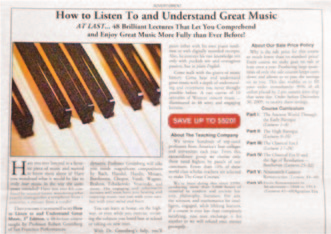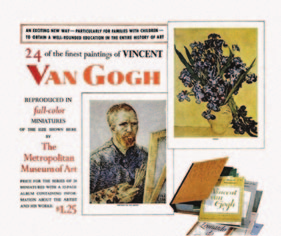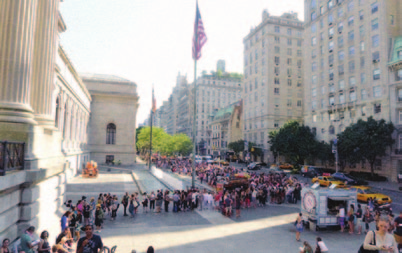How Music Works (49 page)
Authors: David Byrne
Tags: #Science, #History, #Non-Fiction, #Music, #Art

274 | HOW MUSIC WORKS


Below, left, is a promotion the Met did in the sixties in
LIFE
magazine.C The idea was that even reduced to the size of a postcard, reproductions of verified masterpieces could still enlighten the American masses. And so cheap!
Music was (and is) presented in the same way. Below, right, is an ad that
appeared in the
New York Times
Book Review
not too long ago.D This ad isn’t about learning to play for your own enjoyment or self-expression—it’s purely about learning to value the classics more than any music you and your pathetic friends might make. It’s a little more expensive than the $1.25 the Met was
asking for back in the day, but times have changed. The effect, however, is the same: to make you feel anxious and insecure about what you know and might
already like, and to show you how to fix the situation.
This line of thinking led Hoving and others to create the now ubiqui-
tous blockbuster museum show. The first one famously brought King Tut to
the masses—or, more precisely, it brought the masses to Tut. These shows
“reached out,” and made the Met and other like-minded museums into tem-
ples where all were welcome. Hard to remember, but the Met was once a fussy, dusty old place, and that show set it on its way to becoming super popular.
Here are some blockbuster-exhibit attendance figures from the Met:11
• Treasures of Tutankhamun
(1978–79), 1,360,957 visitors
• The Mona Lisa by Leonardo da Vinci
(1963), 1,077,521 visitors
• The Vatican Collections: The Papacy and Art
(1983), 896,743 visitors
• Painters in Paris: 1895-1950
(2000–01), 883,620 visitors
• Origins of Impressionism
(1994–95), 794,108 visitors
C
D


• The Horses of San Marco
(1980), 742,221 visitors
• Picasso in the Metropolitan Museum of Art
(2010), 703,256 visitors Hoving did ride a bike, so he can’t have been all about fancy art.E In fact, his stint as Parks Commissioner, before he joined the Met, was incredibly
fruitful, and changed the lives of many ordinary New Yorkers. He had been
offered the job with no prior experience, so his success belies the idea that we should only put our trust in experts. It was he who closed Central Park to cars on Sundays, and he who established more than one hundred pocket parks
around the city, on vacant lots and in weird, unused parcels of real estate.
And now add to the list of blockbusters the 2011 Alexander McQueen
show, which had folks waiting in line in the sweltering heat for hours.F To be honest, I can understand the McQueen show’s popularity; the others are a bit more of a mystery to me. The presentation of the McQueen frocks involved
a slightly more transgressive aura: they were presented as if they were part of a sci-fi opera, or a sexier version of a sword-and-sorcery world like
Game
of Thrones
. The display created a slightly creepy alternative universe; it was much more than a parade of well-designed dresses on mannequins. That
freaky otherworld that was hinted at seems genuinely populist, much more
so than, say,
The Horses of San Marco
.
John Carey pretty much demolishes the idea that appreciating high art—
and I am going to assume we can transfer his arguments concerning fine art
to music—is inherently good for you. How, he asks, can anyone believe that
art (or music) encourages moral behavior? He concluded that assigning moral
acuity to those who like high art is generally class-based. “Meanings,” he
writes, “are not inherent in objects. They are supplied by those who interpret them. High art is that which appeals to the minority whose social rank places
E
F
them above the struggle for mere survival.”12 The fact that such art has no
practical use—or none that is acknowledged—heightens its appeal.
This line of reasoning leads him to the following conclusion about the art-
builds-character attitude:
One is saying, “What I feel is more valuable than what you feel.” In assuming that high art makes life worth living, there is an inherent arrogance toward the masses of people who don’t partake of such forms… and an assumption that their lives are not worth as much, not as full. The religion of art makes people worse—because it encourages contempt for those considered inartistic.13
Although the idea is continually espoused that art is for all and that all
can benefit from it, I wouldn’t say that the presentation of art is entirely democratic. Though seemingly benign, too often it’s a top-down version of
culture. We want you all to look at it, and listen to it, and appreciate it, but don’t even think you could ever make it yourselves. Moreover, what has been
deemed “real art” has nothing in common with the reality of your daily life.
Twentieth-century British art critic Clive Bell wrote, “To appreciate a work of art we need to bring with us nothing from life, no knowledge of its ideas and affairs, no familiarity with its emotions.”14
“Quality” works are said to be timeless and universal. People like Bell think that they would be good in almost any context. The Scottish Enlightenment
philosopher David Hume insisted that an unvarying standard exists, and that
“[it] has been universally found to please in all countries and in all ages.”15
The implication is that great work should, if it is truly great,
not
be of its time or place. We should not be aware of how, why, or when it was conceived, received, marketed, or sold. It floats free of this mundane world, transcendent and ethereal.
This is absolute nonsense. Few of the works that we now think of as “time-
less” were originally thought of that way. Carey points out that Shakespeare was not universally favored; Voltaire and Tolstoy didn’t care for him much, and Darwin found him “intolerably dull.”16 For many decades his work was derided as low and popular. The same could be said for a “great” painter like Vermeer, who was “rehabilitated” only recently. As a society, we change what we value all the time. When I was working with the UK trip-hop band Morcheeba, they
extolled the virtues of an American seventies band called Manassas. I had
DAV I D BY R N E | 277
dismissed that band when I was growing up—I thought they were great play-
ers but not in any way relevant to me—but I could see that a younger genera-
tion of musicians, without my prejudices, might see them in a different light.
I don’t think that particular band ever got elevated to the “timeless” pedestal, but many others have been. I discovered Miles Davis’s electric jams from the seventies relatively late—for the most part, they were critically frowned upon when they came out—but there might now be a whole generation who looks
on those records as founding gospel, hugely inspirational.
The artist Alex Melamid satirized beliefs about the mystical and moral
power of art in a slideshow I saw, in which he showed photos of himself
holding up reproductions of well-known masterpieces by such artists as
Van Gogh and Cézanne in front of folks in rural Thailand. He was propos-
ing, with tongue firmly in cheek, that exposure to these “spiritual” works
would elevate these “heathens,” and that the artworks might even have some
healing properties. It was hilarious, partly because Melamid kept a straight face throughout, but the point was clear: out of context, the great Western
masterpieces simply are not the transformative icons they are considered to
be back home.
FUNDING
Opera halls, ballets, and large art museums receive more funding—and
not all from the government—than do popular art and what might
be considered popular music venues. This is because of the edifying value
ascribed to such institutions by people of a privileged economic and social
class throughout much of the twentieth century.
This arrangement has become a little hard to parse in America, where
much of the sponsorship and audience for these institutions no longer comes
from old money. Class and wealth were not always synonymous here, but
maybe now they are becoming so. Joining the club that supports these venues
is a way for a Texas oilman or an arms dealer to seem like a more cultured
person. The image is so common as to be a cliché. Jett Rink, James Dean’s
character in the film
Giant
, starts off as oil-field trash, but when he strikes it big he tries to be a society sophisticate. For the most part, the new rich do try to behave and appreciate the same things as the old rich. (Interesting that the 278 | HOW MUSIC WORKS
titans of tech, the nerdopoly, didn’t follow this pattern—they seem to have
little interest in joining those clubs.)
Funding well-established institutions that play “quality” music isn’t only
about a search for status; it is also about keeping many kinds of music or art out of the temple, and discouraging amateurism in general. Hazlitt wrote that
“Professional art is a contradiction in terms… Art is genius, and genius cannot belong to a profession.”17 That would seem to imply that no amount of aid or support could possibly do much good—so why fund the arts at all? But I
think he means that we should support these geniuses, and let the rest—the
ungifted and the unprofessional—fall by the wayside. Marjorie Garber, in her book
Patronizing the Arts
, responded to this idea, writing, “By this logic, [arts]
funding was, in a sense, doomed by paradox: the training, schooling, and fostering of professional artists could only support the
wrong
artists, the nonge-niuses.”18 It’s a bit of a catch-22. The work that has been approved, and that appears in the institutions,
must
be good, because it’s already been included in those institutions. Sort of a closed system, but I guess that’s the idea.
